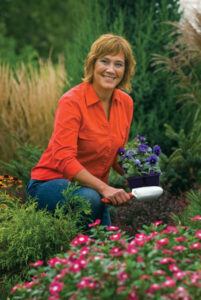As you scour the seed catalogs and websites for new and favorite flower and vegetable seeds, take time to inventory the seeds you have saved from previous years. You’ll save money by not buying more of the seeds you already have so you’ll have more to spend on something new.
Starting with fresh seeds from a reliable seed company helps boost your growing success. But what gardener can resist getting the most out of every purchase by saving and planting seeds left from previous years?
Seeds stored in a consistently cool, not freezing, dry, dark location can last for one to five or more years. Start by checking the packaging or expiration date on the packet. Onions, parsley, parsnips, and salsify seeds usually last one year while corn, okra, and pepper seeds last an average of two years. Beans and peas generally last for three years; tomatoes, turnips, beets chard, and watermelon four; and Brussels sprouts, cabbage, muskmelon, radishes, and spinach are the longest lasting at five years.
Perennial flower seeds last an average of two to four years while annual flower seeds last from one to three years depending on the species. There are always exceptions with a few seeds that were found lasting more than a hundred years.
You may find your properly stored seeds last longer than the averages. But once seeds pass their average life expectancy you may see a reduction in germination. Use this quick and easy test to see if your stored seeds will sprout and grow. Place ten seeds on a damp paper towel. Roll up the towel with the seeds safely tucked inside. Set the paper towel in a plastic bag and store it in a warm dark location.
After a week or so, unwrap the paper towel and check the seeds for sprouting. If nothing has happened, rewrap the seeds and wait a few more days.
If all the seeds have sprouted, you have one hundred percent germination and can plant the seeds according to the label directions. If only half the seeds sprout, you should plant the seeds twice as thick to compensate for the lower germination. You can plant these sprouted seeds if you have the available gardening space and the growing conditions are right for the seeds to grow.
If none of the seeds sprout, consider breaking out the glue and getting the family involved in turning these nonviable seeds into seed art. Then make some adjustments to your seed storage strategies in the future. Leave seeds in their original package so you have all the information you need when inventorying and planting the seeds the following season. Place the envelope in an airtight container and store it in the refrigerator or a consistently cool, not freezing location.
If you’ve lost seeds to hungry rodents try storing them in the refrigerator or metal or glass containers. Sealed plastic containers are fine for the seeds, but hungry mice can eat their way through the plastic to your stored seeds.
You, like many gardeners, often end up with more seeds than you will ever grow. Consider sharing these with others by donating them to school groups, community gardeners, and master gardeners who will put them to use in various gardens in your community. Or organize a seed swap. Just gather your gardening friends or work colleagues, the seeds and catalogs, and throw a garden party. The last Saturday in January is National Seed Swap Day and a good excuse to gather and share.
Seed swaps are a great way to find unusual or unique seeds. It is also a great way to save money and get the greatest value by sharing extra seeds with friends and family.
Once the seed swapping is done you may want to break out the catalogs, check online seed retailers, and place a group seed order. Working together you’ll be able to order a wider variety of seeds for greater diversity in the garden. Everyone can take what they need so there will be fewer seeds to save in the future. Plus, ordering larger packets is usually more economical. And you’ll have an excuse for another party when you meet to divide up the goods.

Melinda Myers has written more than 20 gardening books, including the recently released Midwest Gardener’s Handbook, 2nd Edition and Small Space Gardening. She hosts The Great Courses “How to Grow Anything” instant video and DVD series and the nationally syndicated Melinda’s Garden Moment radio program. Myers is a columnist and contributing editor for Birds & Blooms magazine. Myers’ website is www.MelindaMyers.com.
